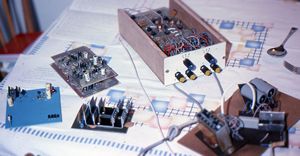It's a sound theory...
One of my hobbies is "hi-fi".

Remember audio? Here's where I own up (during my ongoing quest for [a] listening unsullied by snap, crackle and pop and [b] ever better signal-to-noise ratios) to recording my four Curved Air vinyl LPs...
- on to non-Dolby, mono cassette tapes (1971: a Sony mono radio recorder, <50dB)
- on to non-Dolby, stereo cassette tapes (1973: a Sony stereo1 ditto, <50dB)
- on to Dolby B, stereo tapes (initially [1975] Hitachi deck plus separate Videosonic Dolby B box, <57dB, latterly [1978] Tandberg's tasty TCD330 3-head deck, <60dB)
- on to Dolby C, stereo, tapes (1981: Pioneer CT4, <65dB)
- and on to bias-optimised Dolby C HXPro metal tapes (1983 to 1987: no less than three of the superb Aiwa ADF770, dual capstan, 3-head decks, about 70dB)
... before finally giving away the tapes in 2000 (the vinyl went West a decade earlier) having long since re-bought all four damned LPs on CD by then. (This is surely what's meant by "paying your dues to the audio industry".)
A message to people who email asking for copies
I receive occasional requests for copies of various items. My position is very simple: I do not distribute copyright material.
I shall skip lightly over the brief bout of insanity that was my attempt to build and get working the Wireless World opto-resistor based audio dynamic range compander in 1975 or thereabouts...
 One of numerous iterations in Old Windsor
One of numerous iterations in Old Windsor
... not to mention my equally brief flirtation with a dbx box (a claimed 90dB) while I was for a while a hi-fi reviewer for the Haymarket Press by moonlight, while freelance assembler programming ICL 1500 Series minicomputers2 in the evenings, after my day job in the ICL Education and Training HQ in Beaumont, Old Windsor, but before the arrival of my son in March 1980...
Sonja Kristina's divine warbling / Darryl Way's violin?
While the CDs spent some years safely up in the loft, I listened to the music in the form of companded resampled ATRAC3 DSP Type-S bits strewn (in the case of Curved Air) across just one tiny Sony minidisc (>90dB, never even heard of wow and flutter, number r119 in my collection), thanks for asking! Mind you, I burned out three minidisc recorders during the long (real-time) months during which I recorded all my CDs to minidisc. Funny how these recorders expire about a fortnight after the one-year warranty, don't you think?
Along came the end of 2002, the point at which I finally gave in, and got myself what's laughingly regarded as an "industry standard" Windows PC at home (very reluctantly putting out to pasture the much more elegant Acorn RISC OS machines I'd been using very productively for DTP and other purposes since 1989). Looking around, I realised that the world was now listening to MP3 files (though I wasn't entirely sure why). I could see, however, some distinct advantages to having my entire music collection on a single hard drive. It was a pleasant surprise to find that ripping CDs to MP3 file format was much speedier, but it was still a pretty boring process. My 20GB Creative MP3 Player did nicely for a couple of years on long trips, holding carefully curated subsets of my music.
History being an eternal cycle, I now (2015) once again keep all the CDs downstairs in a series of CaseLogic folders. They are even "somewhat" indexed, and can be hauled out for playing on a pretty good quality NAD CD player or the Oppo Blu-ray player.
Re-ripping progress
Re-ripping3 all the CDs (this time using variable bit rate and highest quality level) has been an odyssey of discovery, too. Not least the discovery that some of the CDs not only failed to make their way through the original (128Kbps) ripping process but, in some cases, never even made it into the database. So the use of the word "all" above is (technically) inappropriate. These larger MP3 files are now safely housed on a variety of hard drives, including my Synology Diskstation NAS from which they can be served, via my Oppo BDP-103EU Blu-ray and network media player (or just played directly from my Linux PC) to the main audio system. But (of course!) they won't now all fit onto the natty little 160GB iPod Classic I acquired at the end of 2007, so I gave that to Junior in 2011.